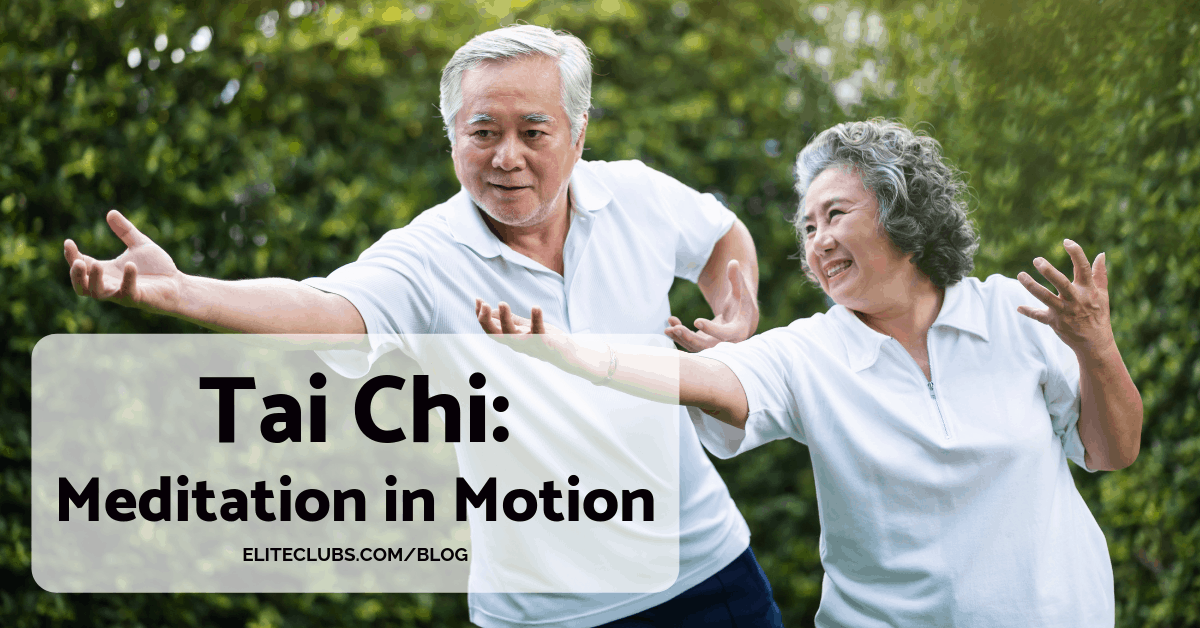Have you ever wanted to try Tai Chi? Elite Sports Clubs offers Tai Chi exclusively at West Brookfield. In this blog, we’ll explore what exactly Tai Chi is and how it will benefit you.
What is Tai Chi?
Tai Chi is an ancient, internal Chinese martial art, with its first principles originating over 1500 years ago with Taoist monks. The primary principle of Tai Chi is profoundly simple – balance. To intentionally harmonize two opposing yet necessary forces traditionally referred to as yin and yang. This balance is exemplified in the movements of Tai Chi: for every exhale an inhale, for every expansion a withdrawal, for every strike a recession, and for every advance a retreat. The principle of balance extends beyond the physical, demanding mental focus and release of distractions. As a result, Tai Chi is oft referred to as “meditation in motion.”
Focus on the Breath
Qigong, or energetic breathing, is essential part of proper Tai Chi practice. The breath is synchronized with movement to focus the mind, relax the body, and effectively strike or absorb force. The vital importance of the breath has very similar concepts you may be familiar with in Vinyasa Yoga practice. In fact, many compare Yoga to Tai Chi in that they share an emphasis on meditative motion and the vital importance of the breath to achieve full benefit from the exercise.
Benefits of Tai Chi
Though originally conceived as both fighting style and path to enlightenment, Tai Chi and Qigong have developed into gentle, rhythmic exercise practiced by millions all over the world today. Regular Tai Chi practice demonstrates significant evidence for improving balance, muscular fitness, bone density, stress relief, and even mental capacity. The prevalence of Tai Chi has led to extensive research on its health benefits over the past 45 years (more than 500 control trials and 120 systematic reviews published in medical journals alone to be exact!) establishing Tai Chi as a powerful tool for achieving a healthier life. Beyond the commonly touted benefits for Tai Chi described above, it has been shown to improve outcomes for conditions ranging as far from depression to Parkinson’s to cardiac rehabilitation. The benefits are numerous enough that I would encourage you to do your own research as there are far too many positive impacts for me to reasonably list here!
Never tried Tai Chi? Join my class, exclusively at West Brookfield!
Written by Collin Christensen, Certified Personal Trainer at Elite Sports Club – West Brookfield.
Matthew has a B.S. in Exercise Science from Carroll University and is an American College of Sports Medicine Certified Personal Trainer. He specializes in Tai Chi, Resistance Training, Olympic Weightlifting, Cardio Kickboxing/ HIIT, Functional Training, and training for Postural Correction. He also specializes in Resistance training for youth, adults, and elderly populations.
References:
Hall A, Maher C, Latimer J, Ferreira M. The effectiveness of tai chi for chronic musculoskeletal pain conditions: a systematic review and meta-analysis. Arthritis Care Res 2009;61(6):717-24.
Lauche R, Langhorst J, Dobos G, Cramer H. A systematic review and meta-analysis of tai chi for osteoarthritis of the knee. Complement Ther Med 2013;21(4):396-406. Epub 2013 Jul 1.
Logghe IH, Verhagen AP, Rademaker AC, Bierma-Zeinstra SM, van Rossum E, Faber MJ, et al. The effects of tai chi on fall prevention, fear of falling and balance in older people: a meta-analysis. Prev Med 2010;51(3–4):222-7. Epub 2010 Jun 15.
Wayne PM. The Harvard Medical School guide to tai chi: 12 weeks to a healthy body, strong heart, and sharp mind.Boston, MA: Shambhala Publications Inc; 2012.


2 Comments
Sounds great When is your class?
Please tell me, when is the Tai Chi class. Beginners welcome?